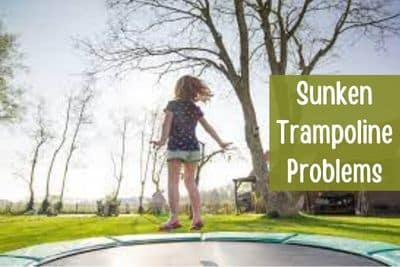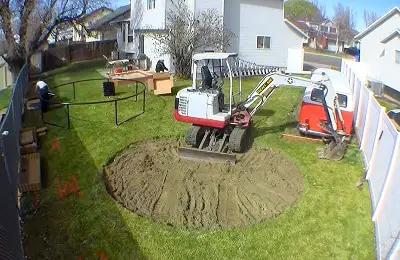No doubt that sunken or in-ground trampoline is the talk of the town for its aesthetics and safety features. Everyone can have fun there. Whether you own a sunken trampoline or want to get one soon, it’s important to know some common issues regarding in-ground trampolines.
What are the sunken trampoline problems? Some of the common issues are complicated installation, retaining wall building, water drainage preparation, immovable trampoline, snakes in a pit, etc. Although you can’t eliminate some of these in-ground trampoline problems fully, there are still ways to reduce the hassle.
This article will take you through some of the key problems of sunken trampolines and tips to fix these. I also cover the pros and cons of in-ground trampolines here. Let’s reveal the facts.
Common Issues of In-Ground Trampolines

In-ground trampolines have lots of features that make them superior to traditional trampolines. However, they have some limitations that you should know before buying one.
Several common in-ground trampoline problems are-
- Complicated installation
- Hole size
- Inadequate airflow
- Retaining wall
- Water drainage
- Unauthorized access
- Snakes in the pit
- Immovability
- Weeds grow
- Ground leveling
- Undergoing critter issue
- Soil composition
How to Fix Sunken Trampoline Problems?
After knowing the difficulties you may face with ground-level in-ground trampolines, let’s talk about how these problems are created and how do you solve them easily.
1. Complicated Installation
In-ground trampolines require more time, effort, and cost to put the trampoline in the ground than the regular trampoline. During the sunken trampoline installation, you have to dig a large hole to install the trampoline there.
Other tasks include building a retaining wall, preparing a drainage system, leveling the ground, etc. These will require hefty costs, time, and physical work.
But once the trampoline is installed, you can use it year after year without much maintenance. And luckily, there are different available sunken trampoline installation services to ease your job.
See Also: Trampoline assembly common mistakes
2. Hole Size
Digging holes is an essential task for sunken trampoline installation. Some people get confused about hole size and depth. And there are several things that you should keep in mind during hole preparation to do it rightly.
- Firstly, when the hole is a little swallower compared to the trampoline height, there is a high chance of a tripping hazard. In this case, if someone couldn’t step up or down properly, he/she might fall into injury. So, the hole should be 1-2 ft wider compared to the frame.
In this case, knowing the trampoline size is important. You can also measure it.
- Secondly, if the hole is leveled with the ground, there will be a lack of ventilation that will affect the bouncing quality directly. You can keep the trampoline a few inches up from the ground to resolve the problem. Also, use safety pads for good ventilation.
3. Inadequate Airflow
In-ground trampolines are installed in the pit. Thus, there is a small space between the pit and the mat. But proper spacing between them is very important for airflow and quality bounce. So, you might experience low and uncomfortable bounces on the sunken trampoline.
That’s why it’s recommended to up the trampoline several inches high from the ground for better airflow and bouncing.

4. Retaining Wall
The retaining wall is a strong barrier between the sunken trampoline pit and dirt. It requires effort and money, but this is necessary to keep the sunken trampoline in place.
For a place with lots of rain, you need a cave-in. Choosing the right material for a retaining wall is a challenging thing, right?
Several materials are used as in-ground trampoline retaining wall kits, such as concrete, brick, metal, wood, etc. To get the right idea about which material suits your lawn soil, consult with an expert.
See Also: Is it okay to sink a usual trampoline in the ground?
5. Water Drainage
Without proper drainage, the sunken trampoline will be flooded due to stagnant water in the pit. It will also be prone to damage the trampoline frame.
The retaining wall of the trampoline will help you understand which drainage will suit there best. Perforated drains that lead to a storm drain or gutter will be a good choice here.
Some users install pump in the sunken trampoline pit for easy water passing. But, you can consult with an experienced contractor for the best suggestion.
See Also: Solution of trampoline ring stuck together issues
6. Unauthorized Access
This is another major problem that you may face with the sunken trampoline. Due to the low-level jump bed, kids, pets, and even wild animals might visit the trampoline, which could be a safety concern.
If wild animals visit the trampoline frequently, there is a high chance that they will harm the trampoline mat. You can use an enclosure net to get rid of this problem.
See Also: How to put a net on a trampoline?
7. Snakes in Pit
Snake in sunken trampoline pit is a common thing that we hear frequently. Either snake enters from the drain or from the underneath mat.
So, how to keep snakes away of the in-ground trampoline? You can keep the surroundings clean, destroy the snakes’ safe den, install a snake-proof perimeter, deterrents scents or sounds, snake traps, predators like dogs, etc.
Here is a recommended snake repellent.
8. Immovability
In-ground trampolines are fixed in the ground, which might be a problem when you go into the garden renovation. So, once you install the trampoline, you can’t shift the trampoline in the new house.
It seems a problem at first, but as this last for a long so, it’s worth actually. You can do necessary backyard innovation even if there is an in-ground trampoline. And it’s quite easy to winterize the sunken trampoline.
9. Weeds Grow
When you install the in-ground trampoline, the soil of the pit should be treated well; otherwise, scrubs, grass, weeds, and plants might be grown there and will take over the trampoline.
See Also: How to deal with the grass under a trampoline?
10. Ground Leveling
For safety, it is necessary to make the trampoline surrounding flat and smooth, so jumpers don’t get hurt on landing or accidentally fall there. Some people may think this a burden, but it’s necessary for the perfect installation of the trampoline.
See Also: Is sunken trampoline safer?
11. Undergoing Critter Issue
Sometimes pets like cats, dogs, birds, and even the toy of your children may inevitably get under the sunken trampoline. Although, there is spring pad, still this may happen anytime. So, how to fix it?
- During installing the trampoline, you can dig all sides hole 1-2 ft wider than of the trampoline frame. This will help if frame lifting is necessary.
- Another good way to solve the issue is removing several springs and detaching the mat from the trampoline, and picking the things easily using the spring tool.
12. Soil Composition
Without proper soil, the soil surrounding the hole will be eroded soon. Clay is not ideal for proper draining. So, it’s quite troublesome to find a good place if your yard has clay soil.
You should look for regular, sandy soil or prepare the soil by adding the right ingredients.
See Also: Springfree trampoline problems
Pros and Cons of In-Ground Trampolines
If you’re interested to know the pros and cons of sunken trampolines, the following points will give you a brief idea.
Pros:
- Aesthetically pleasing
- Lots of exercise and fun
- Easier entry and exit without any ladder
- Safer to use compared to regular trampolines
- Prevent entering kids and pets underneath the jumping bed
- Allow doing versatile landscaping
- Less maintenance needed
Cons:
- Quite expensive
- Higher installation cost
- Hole digging is time-consuming
- Need drainage, venting, retaining wall
- Tripping hazard
- Not movable
- Stagnant water issue
- Uninvited wild animals visit
See Also: In-ground vs above-ground trampoline debate
Final Words
Most issues that you face with sunken trampolines are related to the installation process. Actually, these are not the problems, these are part of the setup, so they can’t be fixed fully. However, you should do these carefully to minimize the hassle.
It’s true that there are a few sunken trampoline problems, such as critters getting stuck under the trampoline, snakes in the pit, immobility, weeds growing, etc. But, these also are reduced or eliminated following the above-mentioned tips.
On overall considering the positive features of the in-ground trampolines win over their negative features. So don’t hesitate to get the sunken trampolines!

Rebecca is a fitness nerd and mother. She was inspired to get into the world of trampolining and rebounding by her husband Robert, who is a well-respected trainer and expert in the field. Now she instructs children, mothers, and teens the basic trampolining and rebounding tricks.
Rebecca is also a passionate blogger, sharing her knowledge and experiences with others in the hope of encouraging them to give trampolining and rebounding a try.
